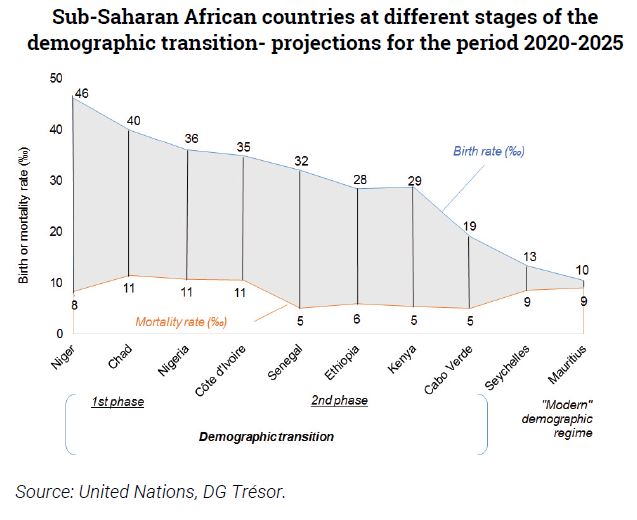Trésor-Economics No. 242 - Demographic transition in Sub-Saharan Africa
Aware of the economic and social benefits that would accrue to them, many countries in sub-Saharan Africa have adopted strategies to accelerate the demographic transition process, which has not yet been completed. The strengthening of education, especially for girls, the improvement of health care provision and the development of social safety nets are among the levers mobilized to this end. Empowering women also promotes a successful transition.
Population trends in sub-Saharan Africa are characterised by concurrent declines in mortality and birth rates, with overall mortality declining faster than the birth rate. The situation differs from country to country and today only Mauritius and Seychelles have demographics that experts would describe as "modern", characterized by low birth and death rates, of some 10 per thousand (see chart on this page). According to United Nations population projections for 2017, these countries will be joined by several others by 2050. By that time, Africa would have just over 2.5 billion people – more than a quarter of the world's population – compared to 1.3 billion today.
Provide appropriate economic and social policies are implemented, the transition can result in "demographic dividends", but for now, the current demographic situation is hampering growth in sub-Saharan Africa. To make matters worse, economic growth, driven by the expansion of sectors that are often not very labour intensive or insufficiently formalised, is unable to absorb the labour market pressures resulting from high fertility rates. Demographic pressure is also leading to uncontrolled urbanisation in several African countries.
Recognizing the economic and social benefits of the demographic transition, many countries have adopted strategies to speed up the process. Improved educational efforts – especially towards girls – improvements in health care and the development of social safety nets are among the means employed to achieve this.
Empowering women and strengthening their decision-making capacities also play a role in a successful transition. However, the measures taken vary considerably between countries.
.
